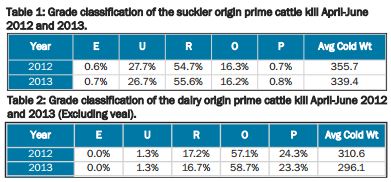



LMC: Carcase Weights Decline Year on Year
NORTHERN IRELAND - The poor weather last summer and issues with both the quality and supply of feed on NI farms over the last twelve months has had an impact on the conformation and carcase weights of cattle presented for slaughter in the NI plants during the period April-June this year, write market analysts at the Livestock and Meat Commission for Northern Ireland.Suckler Origin Beef
Table 1 outlines the conformation of the suckler origin prime kill for the period April-June during 2012 and 2013. There has been a slight movement down a sliding scale in terms of the grades awarded when comparing the two periods but in general conformation has been maintained despite a marked reduction in carcase weights.
The proportion of U grading carcases in the suckler origin prime kill declined by one percentage point to account for 26.7 per cent of the total while the proportion of R grading carcases increased by 0.8 percentage points to account for 55.6 per cent of the total suckler origin prime kill.
Meanwhile the proportion of O and P grading carcases sourced from the suckler herd was fairly unchanged at 16.2 per cent and 0.8 per cent respectively in the 2013 period.
As indicated in Table 1 the average suckler origin carcase weight in the 2012 period was 355.7kg and in the corresponding period in 2013 it was 339.4kg. This represents a decline of 16.3kg year on year which accounts for a five per cent decline in average carcase weights.
The unsettled weather and poor grass growing conditions last summer will have resulted in beef cattle being housed at below target liveweights and with many producers facing issues with the supply and quality of feed stuffs over the winter many cattle would have struggled to reach target slaughter weights.
Assuming an average kill out percentage of 55 per cent prime cattle slaughtered in the 2013 period would have been 30kg (liveweight) lighter than their counterparts in the 2012 period. The costs associated with achieving this extra weight gain during the housing period are likely to have
outstripped the benefits which will have encouraged producers to slaughter animals at lower weights.
Another key factor which must be considered in the preference by the processors for lighter carcase weights. The plants have an ideal carcase weight range of 280-380kg with penalties of 10p/kg for carcases over 420kg. Producers also miss out on the 8p/kg bonus forin spec cattle as there are limited outlets for the larger cuts which these heavier carcases produce.
The combination ofthese bonuses and penalties will have encouraged producers to kill prime cattle at lower carcase weights. Figure 1 displays the spread of carcase weights for the prime kill sourced from the suckler herd for the period AprilJune 2012 and 2013. There has been a notable decrease in the number of prime cattle from the suckler herd killed that have carcase weights in excess of 380kg, falling from 33 per cent of the kill in the 2012 period to 23 per cent of the kill in the 2013 period.
Meanwhile there has been an increase in the proportion of suckler origin prime cattle being slaughtered within the desired weight range of 280-380kg, increasing from 58 per cent in the 2012 period to 65 per cent in the 2013 period. The number of carcases slaughtered at less than 280kg accounted for 8 per cent of the suckler origin prime kill during the 2012 period and this increased to 12 per cent in the 2013 period.
The increased proportion of heifers in the prime kill, up from 34 per cent to 37 per cent year on year, may have had a key role to play in this trend.
Dairy Origin Beef
The dairy herd acts as an important source of prime cattle for the beef industry and accounted for 35 per cent of price reported prime cattle slaughterings during the April-June period in 2013, down slightly from 38 per cent in the 2012 period. Table 2 provides a breakdown of the grades awarded for dairy origin cattle slaughtered from April-June during 2012 and 2013.
These have followed a similar trend to the suckler origin cattle in that the proportion of cattle falling within each grade has remained fairly consistent year on year despite the marked reduction in average carcase weights. The proportion of dairy origin carcases awarded an R grade accounted for 16.7 per cent of total dairy origin slaughterings in the 2013 period, down 0.5 percentage points year on year.
Meanwhile the proportion of O grades awarded increased by 1.6 percentage points to account for 58.7 per cent of the dairy origin kill while the proportion of P grades decreased slightly to account for 23.3 per cent of the dairy origin kill.
The average carcase weight of dairy origin prime cattle during the 2013 period was 296.1kg,14.5kg
lighter than the corresponding period in 2012 when they were an average of 310.6kg. Figure 2 displays the spread of carcase weights for the prime kill sourced from the dairy herd for April-June 2012 and 2013 and indicates that there has been a general downward shift in carcase weights.
In the 2012 period 64 per cent of the dairy origin kill were within the desired weight range of 280 380kg but during the 2013 period only 58 per cent of the dairy origin kill was within this desired range, a reduction of six percentage points.
Meanwhile the proportion of carcases within the 240-280kg weight range increased from 20 per cent in the 2012 period to 27 p er cent in 2013 while the proportion of carcases under 240kg increased from 7 per cent in the 2012 period to 10.7 per cent in the 2013 period.
This downward shift in carcase weights is likely to be a result of a combination of the production
difficulties faced by producers.




